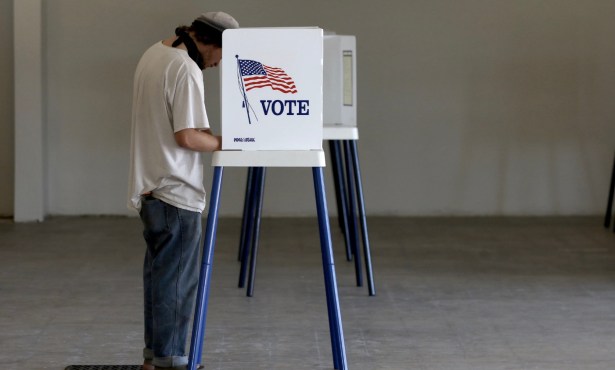Whatever, Dog
BETWEEN THE EYES: This week, the rest of the nation finally caught up with Santa Barbara. I’m referring to the average price for a gallon of gas finally topping the $4 mark. This, of course, was big news, signaling the end of Western civilization as we know it and, if not that, then surely our loss of innocence.
But right here in Santa Barbara, we’ve been paying that much, and more, for a while now. In fact, a couple of stations love their customers so much they’ve been squeezing them to the tune of $4.66 a gallon. As far as I can tell, the world hasn’t ended. Of course, this is Santa Barbara, where we’ve been programmed to pay more for everything. In fact, if we weren’t getting gouged, we’d be downright suspicious.

In this whole oil price scandal, I find myself sadly bereft of a team to root for. Do I side with the oil industry and all its shameless greed? Or am I to identify with American car buyers and all their shameless stupidity? The good news is that if you squint, there are discernable signs of intelligent self-interest sprouting up. For example, the Metropolitan Transit District estimates it will sell nearly 900,000 more bus rides this year than it did in 2005. Likewise, the number of people seeking to piggyback their bus commutes with bike rides also jumped. In the same time period, the number of bikes loaded onto the buses’ bike racks increased by 28,000. We are now confronting new economic realities that have been old news in Europe for a while. In England, the price of gas is still twice what we pay, and in Germany, the average car gets twice the gas mileage of an average American car.
All this brought to mind a particularly gloomy discourse I endured a couple weeks ago on the world oil supply at an energy conference organized by Community Environmental Council. The speech was delivered by Robert Hirsch, a been-there-done-that sort of guy whose portfolio includes stints with Exxon, ARCO, the RAND Corporation, and nearly every agency within the federal government. In 2005, the U.S. Department of Energy asked Hirsch to figure out how much oil was left in the world, how much the industrial economies were consuming, and at what point we’d actually hit the downward slope of petroleum production. With an array of mind-numbing charts and graphs, Hirsch showed how we are fast approaching the maximum oil production capacity worldwide-known as peak oil-and how after that, it’s all downhill. The good news, he said, was that by the year 2050 we’d probably be okay. By that, he meant that the industrial nations of the world would have transitioned into substitute energy sources. But as we sat there with the air conditioner set to replicate the Arctic tundra, Hirsch told us how between the year 2015 and 2050, the world would be one continuous explosion of economic violence, disruption, and trauma. This would be caused by the growing chasm between actual oil available and the amount needed to keep the industrialized economies humming at anything approximating their current capacities. The ensuing economic pain would be on a collision course with any and all efforts to stave off global warming.
Remember the oil crisis of the 1970s and the nasty recession that followed? That will be but a sniffle compared to the pneumonia we can expect. You think you’re getting ripped off at the pump now? These will be the good old days. In this context, no one will give a rat’s ass about the polar bears except to the extent that people can drill for oil underneath the disappearing icebergs on which they once roamed. If we began planning for the shift in energy supplies 20 years out, we’d do okay, he said. If we waited until 10 years, the road would be bumpy. But according to his calendar, we’ve only got seven years left. If anyone showed up drunk for Hirsch’s talk, they got sober in a hurry. By the time he concluded, I was rooting around the trash for a blue plastic bag to wrap tightly around my head.
There’s only so much doom ‘n’ gloom a person can endure, and the conference ended on an upbeat note. Susan Anderson, the traffic czarina with Portland, Oregon, boasted how in her city, helmet hair-the dreaded waffle-head coiffure that afflicts those fashion geeks who wear bicycle helmets-has become the fashion statement of choice even among the three-piece suit set. I think she may have used the word “sexy.” (But even she made no such claims about the dreaded fanny pack.) Anderson, who once lived in Santa Barbara, described how Portland’s City Hall had focused its energy, cash, and resources on crow-barring commuters out of their cars and onto their bikes. Today, 14,000 Portland commuters get to work on their bicycles a day. That’s 5 percent of the city’s total workforce, but in some parts of town, the numbers are closer to 10 percent. This compares favorably to Santa Barbara’s commuting-cyclist stats, but come on, that’s Portland, where even the ducks carry umbrellas. I know Mayor Marty Blum is waging a one-woman crusade to be greener than Seattle, but maybe we should focus on beating Portland instead. There, cyclists are given a cash stipend, thanks to a state energy grant, to ride to work. City Hall has a staff of 12 people whose job it is to make the streets as bicycle safe and friendly as possible. They methodically bombard residents-moving neighborhood by neighborhood-with every inducement to ride imaginable. But it’s more than sweet talk and a few bucks; it’s infrastructure, too. Portland has hundreds of miles of bike paths, but more than that, they have bike boulevards. They’ve hard-wired the culture to be more accepting of two-wheeled transport. In Portland, people ride their bikes to the ballet, and companies aggressively compete to see who can better accommodate the cycling needs of their employees. Leading the pack is a Santa Barbara transplant, Chris King, who manufactures precision bicycle parts. King offers every employee individualized indoor bike parking and has a supply of loaner bikes on hand. As an extra incentive, King offers up to four additional days off-at full pay-for hardcore commuters. I’m not knocking what our own City Hall is doing in this regard; it’s doing a lot. But given our ridiculously beautiful weather, it seems crazy we’re not kicking Portland’s ass. It’s true that pedaling won’t work for everybody. But for a whole lot of people, it sure beats $4.66 a gallon.



